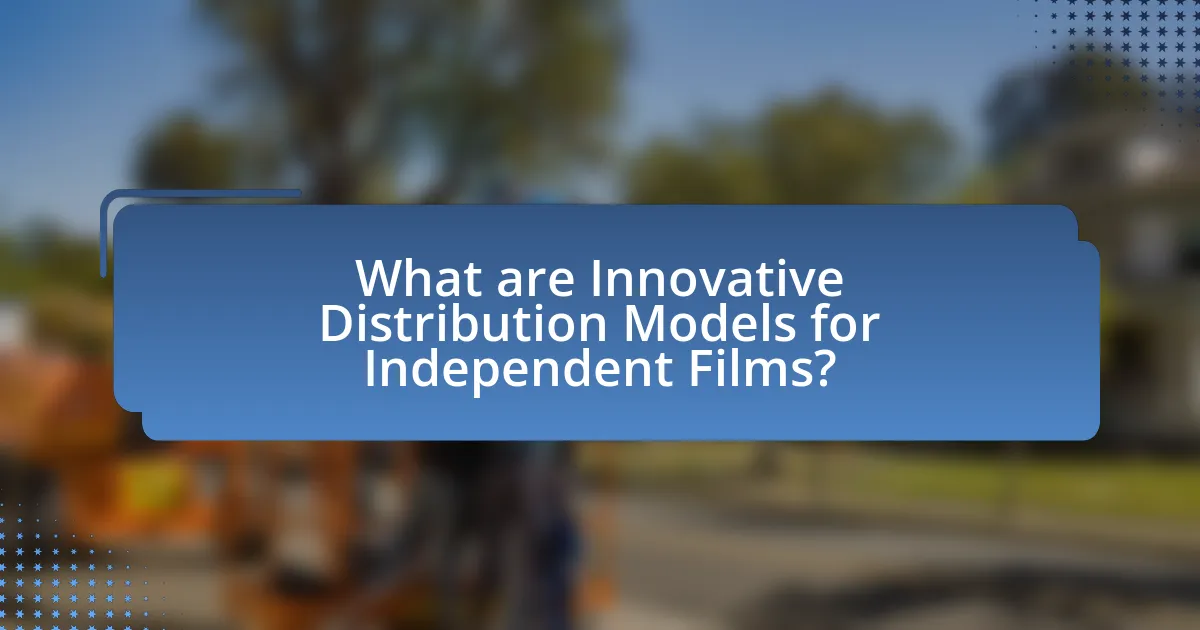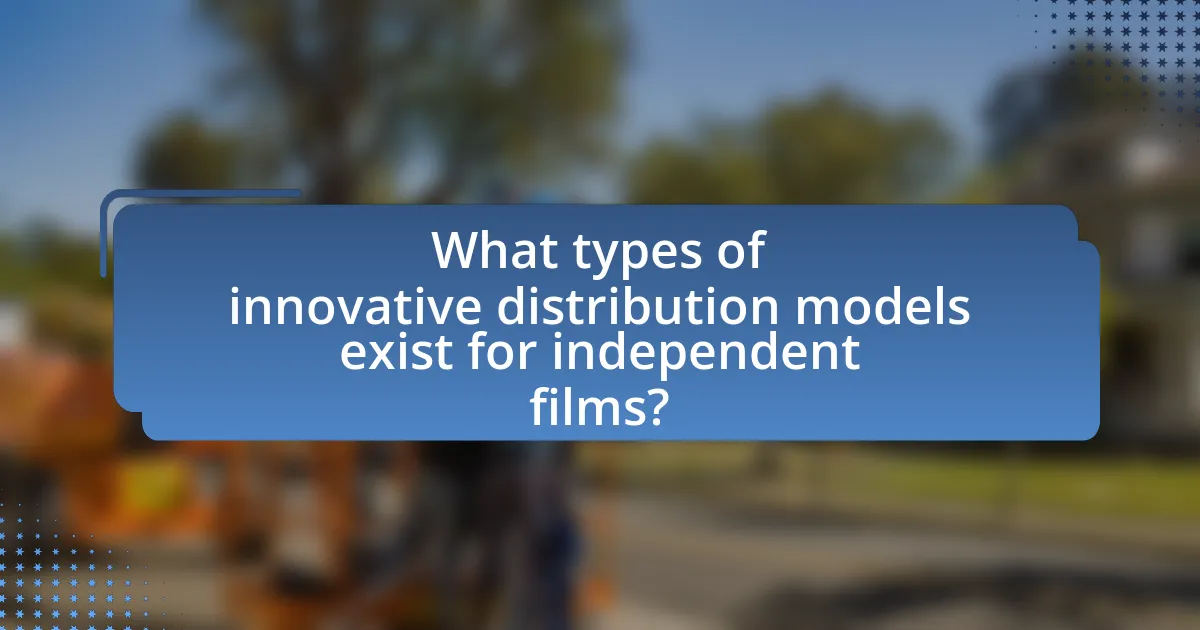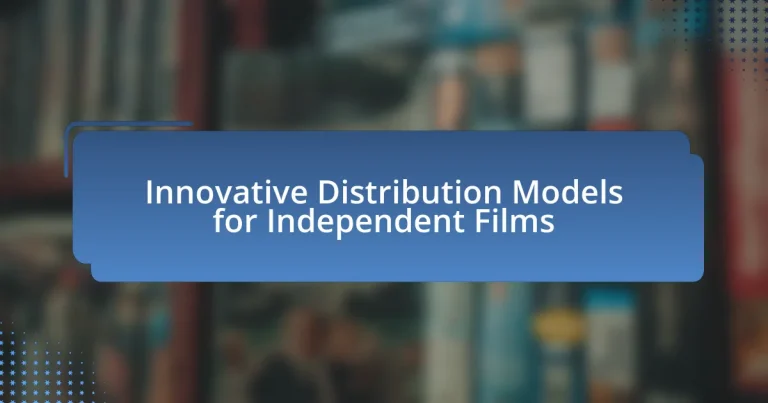Innovative distribution models for independent films encompass digital streaming platforms, crowdfunding, and direct-to-consumer sales, which enable filmmakers to bypass traditional barriers and retain greater control over their revenue. These models contrast with conventional distribution methods that often rely on intermediaries, limiting access for independent creators. The article explores the challenges faced by independent filmmakers in traditional distribution, how innovative models address these issues, and the importance of digital platforms in enhancing film accessibility and audience engagement. Additionally, it discusses the role of crowdfunding, strategic partnerships, and data analytics in optimizing distribution strategies for independent films.

What are Innovative Distribution Models for Independent Films?
Innovative distribution models for independent films include digital streaming platforms, crowdfunding, and direct-to-consumer sales. Digital streaming platforms like Netflix and Amazon Prime Video allow independent filmmakers to reach global audiences without traditional distribution barriers. Crowdfunding platforms such as Kickstarter enable filmmakers to finance their projects while simultaneously building an audience before release. Direct-to-consumer sales through websites or social media allow filmmakers to retain more profits and connect directly with their viewers. These models have gained traction as they provide filmmakers with greater control over their distribution and revenue streams, reflecting a shift in the film industry towards more accessible and flexible options for independent creators.
How do these models differ from traditional distribution methods?
Innovative distribution models for independent films differ from traditional distribution methods primarily in their use of digital platforms and direct-to-consumer strategies. Traditional distribution often relies on intermediaries such as film distributors and theaters, which can limit access and increase costs for independent filmmakers. In contrast, innovative models leverage online streaming services, social media marketing, and crowdfunding, allowing filmmakers to reach audiences directly and retain a larger share of revenue. For example, platforms like Vimeo On Demand and Amazon Prime Video enable filmmakers to distribute their work globally without the need for traditional gatekeepers, thus democratizing access to film distribution.
What challenges do independent filmmakers face with traditional distribution?
Independent filmmakers face significant challenges with traditional distribution, primarily due to limited access to major distribution channels. These filmmakers often struggle to secure theatrical releases, as traditional distributors typically prioritize films with established star power or significant budgets, leaving independent projects overlooked. Additionally, the high costs associated with marketing and distribution can be prohibitive for independent filmmakers, who may lack the financial resources to compete with larger studios. According to a 2020 report by the Independent Film & Television Alliance, only 5% of independent films secure a theatrical release, highlighting the difficulties in gaining visibility in a crowded market. Furthermore, the reliance on traditional distribution models can restrict creative control, as distributors may impose changes to align with mainstream audience expectations.
How do innovative models address these challenges?
Innovative distribution models address challenges in independent film distribution by leveraging technology and alternative platforms to reach wider audiences. For instance, models such as Video on Demand (VOD) and subscription-based streaming services enable filmmakers to bypass traditional distribution channels, reducing costs and increasing accessibility. According to a study by the Independent Film & Television Alliance, independent films distributed through VOD platforms saw a 30% increase in audience reach compared to traditional theatrical releases. Additionally, crowdfunding platforms allow filmmakers to secure funding directly from potential viewers, fostering community engagement and support. These innovative approaches not only enhance visibility but also empower filmmakers to retain creative control and maximize revenue potential.
Why are innovative distribution models important for independent films?
Innovative distribution models are crucial for independent films because they provide alternative pathways for filmmakers to reach audiences without relying on traditional studio systems. These models enable independent filmmakers to leverage digital platforms, such as streaming services and social media, which have grown significantly; for instance, in 2020, streaming accounted for over 80% of the film industry’s revenue, highlighting the shift in consumer viewing habits. Additionally, innovative distribution allows for targeted marketing strategies that can engage niche audiences effectively, as seen with films like “The Blair Witch Project,” which utilized grassroots marketing to achieve box office success. By adopting these models, independent films can achieve greater visibility, financial sustainability, and creative control, ultimately fostering a diverse cinematic landscape.
What impact do these models have on film accessibility?
Innovative distribution models significantly enhance film accessibility by providing independent filmmakers with platforms to reach wider audiences without traditional barriers. These models, such as streaming services and digital distribution, allow films to be available globally, increasing visibility and audience engagement. For instance, platforms like Netflix and Amazon Prime Video have democratized access to independent films, enabling viewers from diverse backgrounds to discover and enjoy content that may not have been available in their local theaters. This shift has been supported by statistics indicating that streaming services have seen a substantial increase in subscriptions, with Netflix reporting over 230 million subscribers as of 2023, illustrating the growing demand for accessible film content.
How do they influence audience engagement and marketing?
Innovative distribution models for independent films significantly influence audience engagement and marketing by enabling filmmakers to reach niche audiences directly. These models, such as video-on-demand platforms and social media marketing, allow for targeted outreach, fostering a more personal connection between creators and viewers. For instance, a study by the University of Southern California found that films utilizing direct-to-consumer strategies saw a 30% increase in audience engagement compared to traditional distribution methods. This direct interaction not only enhances viewer loyalty but also provides filmmakers with valuable feedback, allowing for more tailored marketing strategies that resonate with specific demographics.

What types of innovative distribution models exist for independent films?
Innovative distribution models for independent films include digital streaming platforms, crowdfunding, and hybrid distribution strategies. Digital streaming platforms, such as Netflix and Amazon Prime, allow independent filmmakers to reach global audiences without traditional distribution barriers. Crowdfunding, exemplified by platforms like Kickstarter and Indiegogo, enables filmmakers to raise funds directly from audiences, creating a built-in viewer base before release. Hybrid distribution strategies combine theatrical releases with digital distribution, maximizing audience reach and revenue potential. These models have gained traction as they adapt to changing consumer behaviors and technological advancements, providing independent filmmakers with diverse avenues to distribute their work effectively.
How does digital distribution reshape the landscape for independent films?
Digital distribution significantly reshapes the landscape for independent films by providing filmmakers with direct access to global audiences without the need for traditional distribution channels. This shift allows independent filmmakers to bypass costly marketing and distribution fees typically associated with theatrical releases, enabling them to retain a larger share of their profits. For instance, platforms like Amazon Prime Video and Netflix have democratized film distribution, allowing independent films to reach millions of viewers worldwide. According to a 2021 report by the Independent Film & Television Alliance, over 50% of independent films are now distributed digitally, highlighting the growing importance of this model in the industry.
What platforms are leading the way in digital distribution?
The leading platforms in digital distribution for independent films are Amazon Prime Video, Vimeo On Demand, and Netflix. Amazon Prime Video offers a vast audience reach and flexible distribution options, allowing filmmakers to monetize their content effectively. Vimeo On Demand provides a user-friendly interface and tools for filmmakers to sell their work directly to consumers, emphasizing creative control. Netflix, with its extensive subscriber base, invests heavily in original content, providing independent filmmakers with significant visibility and funding opportunities. These platforms collectively shape the landscape of digital distribution, enabling independent filmmakers to reach wider audiences and generate revenue.
How do filmmakers leverage social media for distribution?
Filmmakers leverage social media for distribution by utilizing platforms like Facebook, Instagram, and Twitter to directly engage with audiences and promote their films. These platforms allow filmmakers to share trailers, behind-the-scenes content, and updates, creating a buzz and fostering community around their projects. For instance, a study by the University of Southern California found that films with active social media campaigns can increase audience awareness and ticket sales by up to 30%. Additionally, filmmakers can use targeted advertising on these platforms to reach specific demographics, enhancing their marketing efforts and maximizing their distribution reach.
What role does crowdfunding play in innovative distribution?
Crowdfunding plays a crucial role in innovative distribution by enabling independent filmmakers to finance their projects directly through contributions from a large number of individuals. This model allows filmmakers to bypass traditional funding sources, such as studios and investors, which often impose restrictive conditions. For instance, successful crowdfunding campaigns for independent films like “Veronica Mars” raised over $5 million in just 11 hours, demonstrating the potential of this approach to mobilize community support and generate funds quickly. Additionally, crowdfunding platforms provide filmmakers with a direct connection to their audience, fostering engagement and building a fan base even before the film’s release. This direct relationship not only enhances marketing efforts but also allows for tailored distribution strategies that align with audience preferences.
How can crowdfunding platforms support independent film distribution?
Crowdfunding platforms can support independent film distribution by providing filmmakers with the necessary funds to produce and market their films directly to audiences. These platforms enable creators to engage with potential viewers early in the filmmaking process, fostering a community of supporters who are invested in the film’s success. For instance, successful crowdfunding campaigns often raise significant amounts of money; in 2020, the average amount raised for film projects on Kickstarter was approximately $10,000, demonstrating the potential for financial backing. Additionally, crowdfunding allows filmmakers to gauge audience interest and build a fanbase before the film’s release, which can lead to more effective marketing strategies and distribution channels. This model not only democratizes funding but also empowers filmmakers to maintain creative control over their projects, ultimately enhancing the independent film distribution landscape.
What are the success stories of crowdfunding in film distribution?
One notable success story of crowdfunding in film distribution is the 2012 film “Veronica Mars,” which raised over $5.7 million on Kickstarter, surpassing its initial goal of $2 million within 10 hours. This campaign demonstrated the power of fan engagement and community support, leading to the film’s successful release and distribution through traditional channels. Another example is “The Blair Witch Project,” which, although not crowdfunded in the modern sense, utilized grassroots marketing and early internet platforms to build anticipation, resulting in a box office gross of nearly $250 million against a budget of $60,000. These cases illustrate how crowdfunding can effectively mobilize audiences and create viable distribution pathways for independent films.

What are the key strategies for implementing innovative distribution models?
Key strategies for implementing innovative distribution models include leveraging digital platforms, building direct relationships with audiences, and utilizing data analytics for targeted marketing. Digital platforms, such as streaming services and social media, enable independent filmmakers to reach wider audiences without traditional gatekeepers. Establishing direct relationships with audiences fosters loyalty and allows for more personalized marketing efforts. Data analytics can provide insights into viewer preferences and behaviors, enabling filmmakers to tailor their distribution strategies effectively. For instance, a study by the Independent Film & Television Alliance found that films utilizing direct-to-consumer models saw a 30% increase in audience engagement compared to traditional distribution methods.
How can filmmakers effectively utilize data analytics in distribution?
Filmmakers can effectively utilize data analytics in distribution by analyzing audience demographics, viewing habits, and engagement metrics to tailor their marketing strategies and distribution channels. By leveraging platforms like Google Analytics and social media insights, filmmakers can identify target audiences and optimize release strategies based on data-driven insights. For instance, a study by the Motion Picture Association found that films with targeted marketing campaigns based on audience data saw a 20% increase in box office revenue compared to those without such strategies. This demonstrates that data analytics not only informs distribution decisions but also enhances overall financial performance.
What metrics should filmmakers track for successful distribution?
Filmmakers should track metrics such as audience engagement, distribution reach, revenue generated, and viewer demographics for successful distribution. Audience engagement can be measured through social media interactions, comments, and shares, indicating how well the film resonates with viewers. Distribution reach includes the number of platforms the film is available on and the geographical areas it covers, which helps assess market penetration. Revenue generated from ticket sales, streaming subscriptions, and merchandise provides a clear indicator of financial success. Lastly, understanding viewer demographics, such as age, gender, and location, allows filmmakers to tailor marketing strategies effectively, ensuring that they reach the right audience. These metrics collectively inform filmmakers about the effectiveness of their distribution strategies and guide future decisions.
How can data inform marketing strategies for independent films?
Data can inform marketing strategies for independent films by providing insights into audience preferences, viewing habits, and engagement metrics. By analyzing data from social media platforms, streaming services, and box office performance, filmmakers can identify target demographics and tailor their marketing campaigns accordingly. For instance, a study by the Sundance Institute found that films with targeted social media campaigns saw a 30% increase in audience engagement compared to those without. Additionally, data analytics can reveal optimal release windows and promotional tactics, enabling independent filmmakers to maximize their reach and impact.
What partnerships can enhance distribution efforts for independent films?
Strategic partnerships with streaming platforms, film festivals, and local theaters can significantly enhance distribution efforts for independent films. Streaming platforms like Netflix and Amazon Prime Video provide access to a vast audience, increasing visibility and potential revenue. Collaborating with film festivals allows independent filmmakers to showcase their work to industry professionals and audiences, often leading to distribution deals. Additionally, partnerships with local theaters can facilitate community screenings, fostering grassroots support and word-of-mouth promotion. These partnerships leverage existing networks and resources, maximizing the reach and impact of independent films in a competitive market.
How can collaborations with influencers boost film visibility?
Collaborations with influencers can significantly boost film visibility by leveraging their established audiences and credibility. Influencers possess the ability to reach niche markets and engage followers who trust their recommendations, which can lead to increased awareness and interest in a film. For instance, a study by the Digital Marketing Institute found that 49% of consumers depend on influencer recommendations when making purchase decisions, highlighting the effectiveness of influencer marketing. By partnering with influencers who align with the film’s themes or target demographic, filmmakers can create authentic promotional content that resonates with potential viewers, ultimately driving ticket sales and streaming views.
What role do film festivals play in distribution strategies?
Film festivals serve as critical platforms for distribution strategies by providing independent filmmakers with opportunities to showcase their work to industry professionals, distributors, and audiences. These festivals often attract key players in the film industry, including buyers and agents, who are looking for new content to acquire and distribute. For instance, the Sundance Film Festival has historically been a launchpad for independent films, leading to significant distribution deals; in 2020, films like “Palm Springs” secured distribution rights for $17.5 million after premiering at the festival. Additionally, festivals can enhance a film’s visibility and credibility, which can lead to increased interest from distributors and potential sales in various markets. Thus, film festivals play a pivotal role in shaping the distribution landscape for independent films by facilitating connections and creating buzz around new releases.
What best practices should independent filmmakers follow for successful distribution?
Independent filmmakers should prioritize building a strong online presence and leveraging social media platforms for successful distribution. Establishing a dedicated website and utilizing platforms like Instagram, Facebook, and Twitter allows filmmakers to engage directly with their audience, creating a community around their work. According to a 2020 study by the Independent Film & Television Alliance, 70% of independent films that utilized social media marketing saw increased audience engagement and ticket sales. Additionally, filmmakers should consider partnering with digital distribution platforms such as Amazon Prime Video, Vimeo On Demand, and FilmFreeway, which provide wider access to global audiences. Research indicates that films distributed through these platforms can reach millions of viewers, significantly enhancing visibility and potential revenue.
How can filmmakers create a strong distribution plan?
Filmmakers can create a strong distribution plan by identifying target audiences and selecting appropriate distribution channels. This involves conducting market research to understand audience demographics and preferences, which helps in tailoring marketing strategies effectively. Additionally, filmmakers should leverage digital platforms, such as streaming services and social media, to reach wider audiences, as evidenced by the rise of independent films on platforms like Netflix and Amazon Prime, which have significantly increased visibility and accessibility for filmmakers. Furthermore, establishing partnerships with distributors and film festivals can enhance exposure and create opportunities for audience engagement, as demonstrated by successful independent films that utilized festival circuits to build momentum before wider releases.
What common pitfalls should filmmakers avoid in distribution?
Filmmakers should avoid the common pitfall of neglecting audience engagement during distribution. Engaging with the target audience through social media and marketing strategies is crucial, as studies show that films with active audience interaction tend to perform better at the box office. Additionally, filmmakers often overlook the importance of understanding distribution channels; failing to research and select the right platforms can lead to poor visibility and limited reach. According to a report by the Independent Film & Television Alliance, films that utilize multiple distribution avenues, such as streaming services and film festivals, significantly increase their chances of success. Lastly, filmmakers should not underestimate the value of a solid distribution plan; a lack of strategic planning can result in missed opportunities and financial losses.


